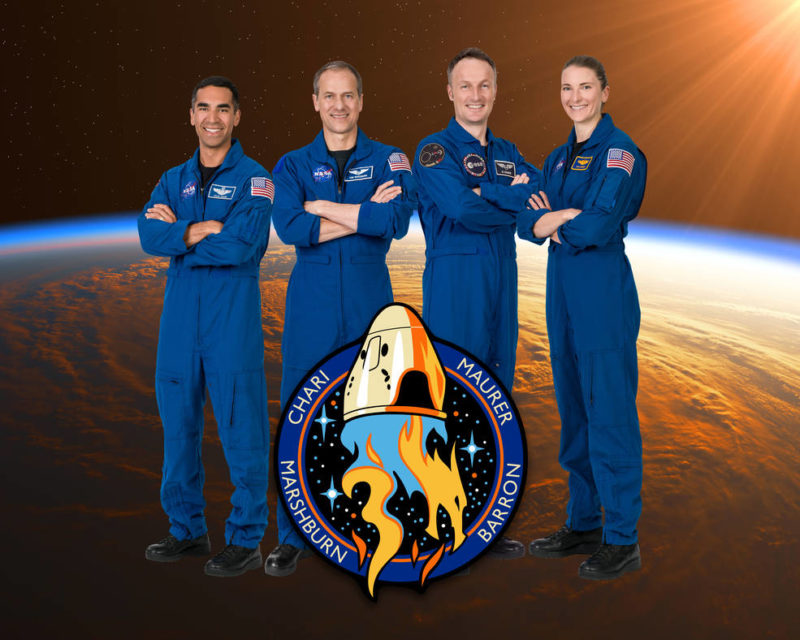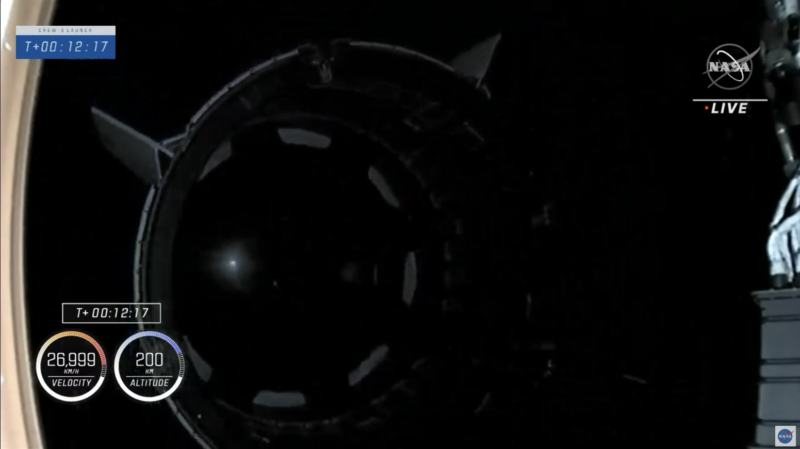
Almost two weeks later than intended, four humans are in orbit aboard Dragon Endurance tonight, en-route for a Thursday evening docking with the International Space Station (ISS). NASA astronauts Raja Chari, Tom Marshburn and Kayla Barron, together with Germany’s Matthias Maurer of the European Space Agency (ESA), rose from historic Pad 39A at the Kennedy Space Center (KSC) in Florida atop a previously-flown Falcon 9 booster at 9:03:31 p.m. EST Wednesday.
Current expectations are that Endurance will dock autonomously at the forward-facing port of the station’s Harmony node at about 7:10 p.m. EST Thursday. Chari, Marshburn, Barron and Maurer will be greeted by Expedition 66 Commander Anton Shkaplerov and his crewmates Pyotr Dubrov and Mark Vande Hei. It is anticipated that the new arrivals will spend six months aboard the ISS.
“With Raja, Thomas, Kayla and Matthias on their way to the International Space Station just days after Crew-2’s return, we’re seeing the power of American ingenuity, right before our eyes,” said NASA Administrator Bill Nelson. “NASA’s partnership with SpaceX is not only critical for cutting-edge research, but also for international collaboration. The space station brings together nations around the world for the benefit of all. Godspeed Crew-3, I can’t wait to see all that you accomplish.”

“What a beautiful evening for a launch. It was another great experience seeing those four guys take off into space on top of that Falcon 9 on that Dragon,” said NASA Associate Administrator Bob Cabana. “It is a huge challenge to safely get humans to and from low-Earth orbit, and the partnerships that we have with our international partners and our commercial crew partners has enabled this space economy that we have right now. What a great time to be part of America’s space program.”
The four astronauts trained for several months in readiness for last night’s launch. Chari, Marshburn and Maurer were announced last December, with Barron added as the fourth crew member in May. Having been in formal training for Crew-3 for less than six months, she has thus enjoyed one of the shortest assignment-to-launch flows of any long-duration ISS astronaut.

Only Marshburn has flown before, having logged over 161 days in space and more than 24 spacewalking hours during his earlier missions aboard shuttle Endeavour on STS-127 in July 2009 and as an ISS long-duration crew member during Expeditions 34/35 between December 2012 and May 2013.
Chari, meanwhile, becomes one of few Americans to command a mission on his very first orbital spaceflight, joining a unique club which also includes Frank Borman and Neil Armstrong.

As previously outlined by AmericaSpace, Crew-3 was originally scheduled to fly in the small hours of Halloween morning, 31 October, but launch was postponed until no sooner than 3 November, as a large, meandering storm system progressed through the Ohio Valley and across the northeastern United States.
This was expected to significantly “elevate winds and waves in the Atlantic Ocean along the Crew Dragon flight path” and it was deemed prudent to scrub the attempt. A further delay was then put into effect, following “a minor medical issue” with one of the Crew-3 astronauts. Launch was pushed back to no sooner than 6 November and finally the 10th as the Florida weather deteriorated.

Original plans envisaged a “direct handover” between the outgoing Crew-2 and incoming Crew-3 astronauts on the ISS. But as she often does, Mother Nature had other ideas. Crew-2’s return on the 7th was pushed back by 24 additional hours, in response to unfavorable winds in the splashdown zone in the Gulf of Mexico, whilst the picture at KSC looked similarly gloomy, obliterating hopes of flying Crew-3 in the first third of November.
Mission managers ultimately elected to prioritize the Crew-2 return on Monday night over the Crew-3 launch on Wednesday night, creating an “indirect handover” situation and leaving the ISS for a few days with a reduced three-man crew of Shkaplerov, Dubrov and Vande Hei.

In the meantime, teams at KSC wrapped up the Delta Launch Readiness Review (LRR) on Tuesday, which concluded with a definitive “Go” to proceed with Wednesday’s launch, notwithstanding a minor issue when one of Dragon Endeavour’s four main parachutes deployed 75 seconds later than intended during Monday night’s splashdown.
In comments provided at a Tuesday media teleconference, Commercial Crew Program Manager Steve Stich explained that the parachute issue was a known condition and the episode posed no risk to returning Crew-2 astronauts Shane Kimbrough, Megan McArthur, Aki Hoshide and Thomas Pesquet.

Mr. Stich added that whilst the deployment was “a little slower than the others”, its rates were “within parameters” and in any case teams aim for a minimum of three parachutes to be fully operational to support the splashdown of a Crew Dragon.
Interestingly, as highlighted by SpaceX Director of Dragon Mission Management Sarah Walker, it is expected that Tuesday—the day following Crew-2’s return home and the day preceding Crew-3’s launch—should mark the only day in 2021 not to see a Dragon spacecraft in orbit.

With Dragon Resilience docked to the station between November 2020 and last May, in support of Crew-1, and Dragon Endeavour docked from late April to last Monday, SpaceX vehicles have assured an almost unbroken chain of human presence on the sprawling outpost.
Added to that list, the presence of the CRS-21 Cargo Dragon at the station over last year’s Christmas and New Year period marked the first time that two Dragons had been in orbit simultaneously. That record notched up to three Dragons in September, with the CRS-23 Cargo Dragon and Crew-2’s Endeavour docked to the space station, plus the all-civilian Inspiration4 crew in independent flight aboard Dragon Resilience.

Heading into Wednesday night’s launch attempt, meteorologists from the 45th Weather Squadron at Patrick Space Force Base predicted a 70-percent likelihood of acceptable conditions, cautioning that the main concerns centered upon cumulus clouds and flight through precipitation. Weather along the Crew Dragon’s flight path, in the event an abort became necessary, was also acceptable.
The four astronauts awoke yesterday afternoon and after weather briefings and donning of their customized SpaceX launch and entry suits, they departed the Neil A. Armstrong Operations & Checkout Building at the T-3 hours and 20 minutes mark.

Shielded from the rain by umbrella-wielding suit technicians, they boarded three Tesla Model Xs—the rearmost of which bore the tongue-in-cheek license-plate “S3ND IT”—and headed for Pad 39A. They began boarding Endurance around T-2 hours and 30 minutes and the hatch was closed and pressure-checked at the two-hour mark.
As is customary, loading of the Falcon 9 with liquid oxygen and a highly refined form of rocket-grade kerosene got underway at T-35 minutes, as darkness fell, and the 230-foot-tall (70-meter) booster was declared fully fueled by T-1 minute and 30 seconds.

By this time, the weather outlook had improved markedly to 90-percent favorable. At 45 seconds, the Launch Director advised the crew that they were “Ho for Launch”. Cool as a cucumber, Chari came back with a clipped reply: “Endurance copies. Go for Launch!”
Liftoff occurred at 9:03:31 p.m. EST, right at the split-second of an “instantaneous” launch window, and B1067 powered away from Pad 39A for the second mission of her career with a combined impulse of 1.5 million pounds (680,000 kilograms). The core stage burned for 2.5 minutes, before it separated and commenced its descent to a smooth landing on the deck of the Autonomous Spaceport Drone Ship (ASDS) in the Atlantic Ocean.

Original plans called for “Just Read the Instructions” to be used for Crew-3’s booster, but this was substituted for the newest ASDS, “A Shortfall of Gravitas”. According to SpaceX Vice President of Mission Assurance Bill Gerstenmaier, JRTI “got beat around pretty bad with the rough weather off the East Coast” and has returned to port.
Last night’s launch of Crew-3 marked the second Falcon 9 “catch” for ASOG, which first saw service to recover the four-times-flown B1061 core following the CRS-23 mission back in August.

Meanwhile, the Merlin 1D+ Vacuum engine of the Falcon 9’s second stage came to life, just over the coast of North Carolina, and burned for six minutes to deliver Dragon Endurance and her first human crew into low-Earth orbit. The spacecraft separated from the booster a little over 12 minutes into the flight and the nose cone was opened shortly thereafter to expose her docking mechanism.
In the opening minutes of the mission, the crew revealed their traditional “zero-G indicator”, which Barron had taken pains to keep under wraps before launch. It turned out to be a plush toy turtle, reflecting the nickname—“the Turtles”—of the 2017 astronaut class to which both she and Chari belong.

At the time that this AmericaSpace story was being prepared, the crew were set for at eight-hour sleep period from 6 a.m. EST to 2 p.m. EST Thursday, before heading directly into final rendezvous and docking activities. Current plans call for Dragon Endurance to dock autonomously at the forward-facing port of the station’s Harmony node at about 7:10 p.m. EST.
Launching on the eve of Veterans Day (and docking on the historic day itself) proved particularly poignant for Chari, a colonel in the U.S. Air Force. At the post-launch press conference, NASA Associate Administrator for the Space Operations Mission Directorate Kathy Lueders recalled Chari telling her that he regretted that Crew-3 had been unable to pull off a Halloween launch, but “look what we did for veterans!”






10 Comments
10 Pings & Trackbacks
Pingback:Watkins Assigned to Crew-4 Mission, As SLS Prepares to Roll – AmericaSpace
Pingback:NG-16 Cygnus Departs Space Station, Heads for Re-entry – AmericaSpace
Pingback:SpaceX Launches DART Mission on Ten-Month Impact Trek to Binary Asteroid – AmericaSpace
Pingback:EVA Youth & Experience Tackle Tricky S-Band Antenna Replacement – AmericaSpace
Pingback:SpaceX Launches Second Mission in 15 Hours, CRS-24 Up Next – AmericaSpace
Pingback:Biden-Harris Administration Extends ISS Operations Through 2030 – AmericaSpace
Pingback:SpaceX Launches Record-Tying Falcon 9, Looks Ahead to Busy March – AmericaSpace
Pingback:Vande Hei Discusses Longest Single U.S. Human Space Mission - AmericaSpace
Pingback:First All-Private Mission Flies, Heads for Space Station - AmericaSpace
Pingback:Crew-4 Aims for Pre-Dawn Wednesday Launch to Space Station - AmericaSpace